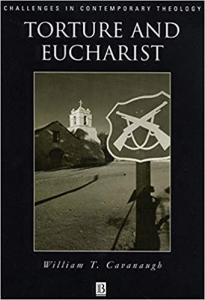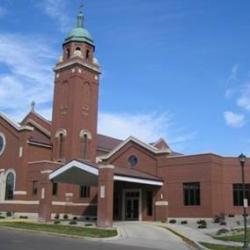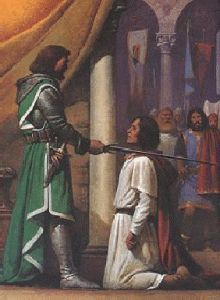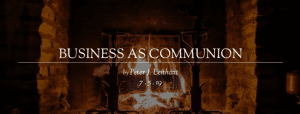
It has occurred to me to wonder about Jesus’ suffering during his trial and execution. How would it compare to the pains that many others have had forced on them? What would Jesus’ sufferings mean for you if you actually suffered more than Jesus? William T. Cavanaugh begins his Torture and Eucharist, on the Chile of the Augusto Pinochet regime, with that question.
This is the second post on William T. Cavanaugh’s book Torture and Eucharist: Theology, Politics, and the Body of Christ. The book discusses the Church’s role in the world in general and the particular situation of the Church in Chile during the years of the Pinochet regime. Introduction and a developing table of contents for this series are here.
Suffering is a topic for meditation, for example, when we pray the Stations of the Cross. But it isn’t that Jesus’ physical pain was greater than everyone else’s. Jesus hung on the cross for three hours. His total passion, from its beginning at the Garden of Gethsemane to his death, lasted less than a day. History tells us other criminals (in the eyes of the Roman state) suffered for days on their crosses. Modern torture regimens typically go on for weeks or more. Of mental suffering, too, Jesus had plenty, but I wouldn’t say the mental suffering of the mother of a disappeared Chilean child was any less.
Martyrs
We say, in penitential mood, “By his stripes we are healed,” and imagine an infinite price Jesus paid for our salvation. Of course, we wouldn’t have been able to pay that price, but Jesus, because he was both God and man, could and did. That’s the account of atonement that has been taught for the nearly thousand years since St. Anselm. How does that understanding change when we realize Jesus’ “stripes” were not infinite, not even exceptional? What can Jesus’ suffering mean for one who actually has suffered more than Jesus? If it has any meaning, paying a price doesn’t seem to capture it.
The experience of suffering under the brutal Pinochet regime in Chile raises the question, What does Jesus’ suffering mean? Cavanaugh asks it in the very beginning of Torture and Eucharist. I don’t find an answer spelled out anywhere, but the story that he tells, of torture’s effects and the people’s response, gives a kind of answer. It does not depend on quantifying torture but on the voluntariness of joining oneself to others’ suffering. The career of Pinochet nears its end when martyrs appear among torture’s victims.
Torture and the modern state
One of Cavanaugh’s long-term interests is the origin and meaning of the modern state. He pursues this theme in other writings, like Migrations of the Holy: God, State, and the Political Meaning of the Church. In Torture and Eucharist Cavanaugh names the project of the modern state one of “creating individuals.” The state isolates people from each other and weakens traditional groupings within which they formerly found support. I think Cavanaugh would agree that this result comes not from the state as a political entity alone but in conjunction with a closely tied capitalist economy.
That project of making individuals depend on nothing but the state is on view in Pinochet’s Chile, particularly in its use of torture. Torture
… atomizes the citizenry through fear, thereby dismantling other social bodies which would rival the state’s authority over individual bodies. (2)
Chile under Pinochet was an extreme example of what modern states do generally, though more subtly.
Torture was different in ancient and medieval times. In those days regimes used torture for punishment and reform of the individual. In wartime torture was used to extract information. Society with its traditions and support groups carried on, chastened perhaps but not fundamentally changed. In Chile the torture process aimed to remake society. Society would become merely a collection of isolated individuals dependent only on the state.
The modern state presents itself as the guarantor of the rights of the individual against other, more powerful individuals. Families, guilds or unions, professional organizations, churches and other intermediary social bodies also have a role. When these latter institutions atrophy, one of the results of the state’s use of torture, the individual has little recourse. The plot line of Torture and Eucharist involves the re-emergence of the Church as an effective social body, the Body of Christ.
Some themes at play in Torture and Eucharist
The distinction between state and society is important throughout Torture and Eucharist. So also is the separation of politics and religion. In the imagination of the state, both society and religion are areas of conflict, from which the state “saves” us. The state appropriates all legitimate use of violence to itself. It’s a common theme today, but Cavanaugh questions “this imagination of a prior conflict from which the state saves us.” (p. 8)
Liturgy is another theme important for Cavanaugh. He calls torture a perverted liturgy. Torture is a sign and realization of the state’s power. The perverted liturgy of torture organizes bodies
… into a collective performance, not of true community, but of an atomized aggregate of mutually suspicious individuals.” (p. 12)
Cavanaugh criticizes the idea that reduces the Church’s liturgy to signs of grace already active in the world. There is a kind of counter-politics at play in the liturgy, especially the Eucharist. The Eucharist is sign but also reality of God’s grace in the world. It is “true politics,” “the public performance of the true eschatological City of God in the midst of another City which is passing away.” (p. 14)
Concluding the Introduction
Cavanaugh describes two difficulties in writing Torture and Eucharist. The first is the difficult task of the attempt by an outsider to let Chilean voices speak. The second is the difficulty of knowing how and whether to make generalizations from the Chileans’ experience.
The events in this book happened in Chile in the 1970’s and 80’s. The danger is for North Americans to breathe a sigh of relief: “Thank Goodness, that doesn’t happen here.” But when it comes to torture, the leaders of the “free” world are not innocent. More than that, “even where torture is absent the power of modern states is often predicated on the same control of bodies and individualization of the citizenry at which torture aims.” (p. 15)
For me the importance of Torture and Eucharist is in the way it expands the notion of body. There are social as well as individual bodies. The focus on body adds new and counter-cultural meaning to Church and Eucharist. That will become clear in the posts to follow.
Image credit: Amazon.com via Google Images












